Theodore von Kármán
| Theodore von Kármán | |
|---|---|
| Personlig information | |
| Født | 11. maj 1881 Budapest, Ungarn |
| Død | 7. maj 1963 (81 år) Aachen, Nordrhein-Westfalen, Tyskland |
| Nationalitet | |
| Far | Maurice von Kármán |
| Mor | Helene Konn |
| Søskende | Elemér Kármán, Pipö von Kármán |
| Uddannelse og virke | |
| Uddannelsessted | Budapest Universitet for Teknologi og Økonomi (til 1902), Georg-August-Universität Göttingen (1906-1908) |
| Medlem af | Royal Society, Calcutta Mathematical Society, Association Française des Ingénieurs et Techniciens de l'Aéronautique et de l'Espace, Associazione Italiana di Aerotecnica, Institute of the Aerospace Sciences med flere |
| Beskæftigelse | Rumfartsingeniør, astronom, universitetslærer, fysiker, matematiker, opfinder, idist, ingeniør |
| Arbejdsgiver | Georg-August-Universität Göttingen, California Institute of Technology, RWTH Aachen (1912-1930), Ganz (1902-1906) |
| Arbejdssted | Aachen |
| Elever | Qian Xuesen, Hu Ning |
| Kendte værker | Kármán-linjen |
| Nomineringer og priser | |
| Udmærkelser | Carl Friedrich Gauß-Medaljen (1960), officer af Æreslegionen (1947), Großes Verdienstkreuz mit Stern des Verdienstordens der Bundesrepublik Deutschland, Storkors af Forbundsrepublikken Tysklands fortjenestorden, æresdoktor (1953, 1956, 1957, 1960) med flere |
| Information med symbolet | |
Theodore von Kármán (oprindeligt ungarsk navn Szőllőskislak Kármán Tódor, født 11. maj 1885, død 7. maj 1963) var en ungarsk-amerikansk fysiker og ingeniør, der primært arbejdede inden for rumfarten. Sammen med sin læremester Ludwig Prandtl skabte han en række fremskridt inden for aerodynamikken, specielt inden for beskrivelsen af supersoniske og hypersoniske luftstrømninger.
Fédération Aéronautique Internationale har defineret at verdensrummet begynder i 100 km højde. Dette kaldes for Karmanlinjen, opkaldt efter Theodore von Kármán.
Eksterne henvisninger
| Spire Denne naturvidenskabelige biografi er en spire som bør udbygges. Du er velkommen til at hjælpe Wikipedia ved at udvide den. |
|
Medier brugt på denne side
Left->right: Ludwig Prandtl (German scientist), Tsien Hsue-sen (Chinese scientist), Theodore von Kármán (Hungarian-American scientist). Prandtl served for Germany; von Kármán and Tsien served for US Army; after 1956, Tsien served for China (Tsien was deported by US government to China in 1955). Notice that Tsien had US Army rank. Prandtl was doctoral advisor for von Kármán; von Kármán was doctoral advisor for Tsien.
Forfatter/Opretter:
SVG by Indolences.
Recoloring and ironing out some glitches done by Rainer Klute., Licens: CC BY-SA 3.0Stylised atom. Blue dots are electrons, red dots are protons and black dots are neutrons.
Dr. Theodore von Karman, co-founder of the Jet Propulsion Laboratory (JPL) Pasadena, California was an aeronautical theoretician. His contributions in the fields of aerodynamics and aeronautical engineering are well documented and well known to every aerospace engineer.
He was the first winner of the prestigious U.S. Medal of Science presented to him by President John F. Kennedy. As well as being co-founder of JPL, he also was principal founder of a major rocket propulsion firm (Aerojet-General Corp.), the top science advisor to the U.S. Air Force during its transition to jet propulsion aircraft and the top science advisor to NATO.
He was, during much of this time, the fountainhead of aerodynamic thought as head of the Guggenheim Aeronautical Laboratory at the California Institute of Technology (GALCIT) in Pasadena, California. In the May 1956 issue of the Journal of Aeronautical Sciences, it was said of him that "No other man has had so great an impact on the development of aeronautical science in this country. Hundreds of young men became his students and scientific collaborators and were inspired to greater effort." Dr. William H. Pickering, then director of JPL said in 1960 "We wouldn't have an aeronautical science as we know it today, if it weren't for Dr. Thoedore von Karman."
Under his guidance, Caltech's 10 foot wind tunnel was designed, built and operated. Industry firms such as Douglas, Northrop, Hughes, Lockheed, North American, Vultee and Consolidated all tested new aeronautical designs and concepts in GALCIT's tunnel. Even Boeing's own high-speed wind tunnel was heavily influenced by suggestions from von Karman.
The National Advisory Committee for Aeronautics (NACA) became so concerned about GALCIT's growing influence over West coast aviation, it erected the Ames Laboratory in Sunnyvale, California in part to deter an ever widening aeronautical gap that had formed between NACA and GALCIT. From 1936 to 1940, Caltech stood alone as the only university-based rocket research center. Von Karman gambled his prestige by supporting Frank Malina and H.S. Tsien's work on rocketry. Other institutions of higher learning dismissed such research as 'fantastical' and left such endeavors to visionaries like Robert Goddard.
Foundational theoretical research by Von Karman gave rise to the first successful solid-fuel rocket engine firings. This led to federal funding for studies that lead to a form of aircraft rocket propulsion called Jet Assisted Take-Off or (JATO). Success in this endeavor led to von Karman establishing two more highly regarded institutions; both originally dedicated to rocketry: the Aerojet Engineering Company and the Jet Propulsion Laboratory.
The last years of his life were spent in Paris, his favorite city. His interest in aeronautical research and contributions to it never waned. He organized in Paris the NATO Advisory Group for Aeronautical Research and Development (AGARD). Staffed by American and European scientists eager to serve, its many committees investigated such disciplines as propulsion, aerodynamics and electronics. The legacy of his personable leadership and 'soft touch' approach to problem solving was only equalled by his genius.





